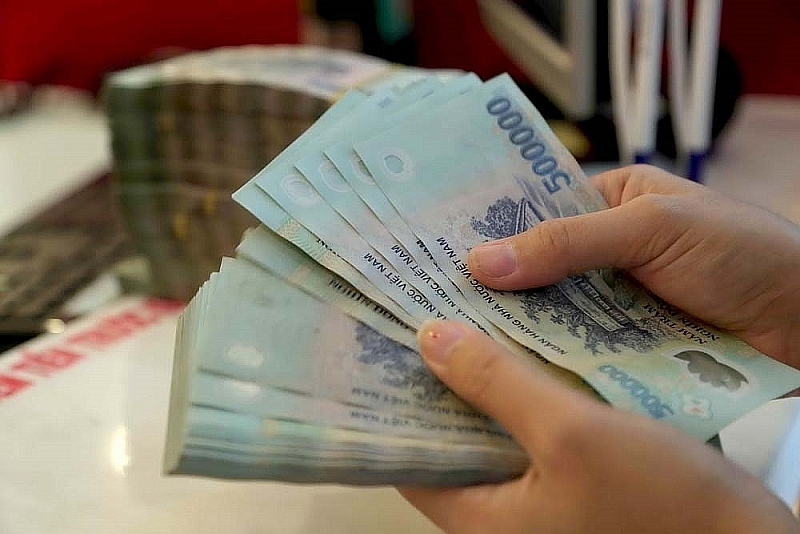Bad debts at some banks have skyrocketed
| Concerned about amending regulations on debt restructuring time | |
| "Upgrading regulations" into a law on bad debt handling | |
| MoF responds to settlement of collateral of bad debts |
 |
| From the beginning of 2021, many experts warned of the escalation of bad debts. Photo: Internet |
According to the announcements of business results and financial statements, Vietbank is the only bank with retrogressive business results in the third quarter, decreasing by 20% compared to the same period last year.
Analysis of Vietbank's third quarter financial statements also shows that, by September 30, 2021, the bank's total bad debt was more than VND1,240 billion, up 58.5% compared to the beginning of the year. Meanwhile, its loan balance increased only 4.8% to nearly VND47,000 billion. Therefore, the bad debt ratio has increased significantly from 1.75% at the beginning of the year to 2.65% after 9 months of 2021.
Similarly, due to operating mainly in Ho Chi Minh City and Southern provinces, Saigonbank was heavily affected by the pandemic, all business activities of the bank were profitable, but the core business was growing slowly. As a result, this bank has to increase its risk provision expenses by nearly 58% to VND42.6 billion.
In particular, the total bad debt of Saigonbank increased by 38%, to VND309 billion by September 30, 2021. Especially, in spite of the slight decrease, group 3 debts, group 5 debts (debts capable of losing capital) skyrocketed which still accounted for the highest proportion in the bad debt structure. As a result, Saigonbank's bad debt-to-loan ratio increased from 1.44% at the end of last year to 2.05% at the end of September 2021.
| According to Standing Deputy Governor of the State Bank of Vietnam, Dao Minh Tu, in the past 10 years, had it not been for the support from Resolution 42/2017/QH14 on piloting bad debt settlement, dealing with bad debts would have been very difficult. If there is no pandemic, the bad debt target of less than 3% will be achieved. However, the impact of the pandemic caused the supply chain to break; businesses cannot afford debts due to cash flow shortage. As a result, it is inevitable that bad debt in the economy increased. In this context, the State Bank has directed banks to actively prevent risks and step up provisioning. Banks are allowed to set aside for three years, at least 30% of the debt to be restructured each year. |
At ABBank, the quality of loans also showed signs of decreasing. By September 30, 2021, ABBank's total bad debt has increased by 46% compared to the beginning of the year, to nearly VND1,940 billion. While debts in such groups as 4, 3, and 5 was down by 21%, 3 times and 52%, respectively compared to the beginning of the year. Therefore, the ratio of bad debt to total outstanding loans of this bank increased to 2.91%, compared with 2.09% at the end of 2020.
In the 9 month period, NCB recorded pre-tax profit of nearly VND206 billion, 7.2 times higher than the same period last year. However, NCB's total bad debt increased by 31% compared to the beginning of the year. In which, the strongest increase was in sub-standard debt, pushing the ratio of bad debt to outstanding loans to increase from 1.51% at the beginning of the year to 1.94%.
According to the financial report for the third quarter of 2021, PG Bank reported profit in the third quarter 4.6 times higher than the same period last year, but bad debt increased by 13% compared to the beginning of the year, recording VND708 billion of bad debt. In which, sub-standard debt increased the most by 52%, bringing the ratio of bad debt to outstanding loans increased from 2.44% at the beginning of the year to 2.75%.
In the large banking sector, despite having a 9-month pre-tax profit of more than VND17,000 billion, which is expected to be higher than Vietcombank, Techcombank's bad debt volume has increased by 41% compared to the beginning of the year, to nearly VND1,830 billion. Especially, subprime debt surged to 74%. As a result, the ratio of bad debt to total loans of this bank increased from 0.47% at the beginning of the year to 0.57% after 9 months.
The Government's report to the National Assembly on the economic restructuring plan for the 2021-2025 period, including the plan to restructure the credit institution system, also acknowledged that debt targets may not be met due to the Covid- 19.
According to the State Bank of Vietnam (SBV), by the end of June 2021, if on-balance sheet debt, off-balance sheet debt and restructured debt are included, the ratio of bad debt and potential bad debt is up to 7.21%. (At the end of 2020 is 5.08%).
Currently, financial statements have not been published in many banks, especially large ones, so the bad debt picture may be different. But now, the bad debt ratio tends to increase at small and medium-sized banks, because large banks have actively increased the risk reserve "buffer" to better cover the bad debt ratio. Therefore, although this motivation has a negative effect on profits, it has a brighter "picture" of bad debt.
Therefore, in addition to increasing their risk provisions, debt settlement is also being carried out by banks. Many banks have focused on handling collateral of borrowers, helping to reduce the volume of bad debts to some extent. The good news is on October 15, Vietnam Asset Management Company Limited (VAMC) officially announced to put the Debt Exchange Branch into operation. The mission of the Debt Exchange is to become a brokerage center, advising organizations and individuals to buy and sell debts and collateral of debts.
Related News

A “picture” of bank profits in the first nine months of 2024
09:42 | 19/11/2024 Finance

Fiscal policy needs to return to normal state in new period
09:54 | 04/11/2024 Finance

Stipulate implementation of centralized bilateral payments of the State Treasury at banks
09:29 | 29/10/2024 Finance

How does the Fed's interest rate cut affect Vietnam?
11:56 | 05/10/2024 Headlines
Latest News

Monetary policy forecast unlikely to loosen further
15:51 | 22/11/2024 Finance

World Bank outlines path for Vietnam to reach high income status
13:44 | 22/11/2024 Finance

Strictly control public debt and ensure national financial security 2025
09:26 | 22/11/2024 Finance

Revising the title of a draft of 1 Law amending seven finance-related laws
14:33 | 21/11/2024 Finance
More News

Transparency evates the standing of listed companies
09:47 | 21/11/2024 Finance

State-owned securities company trails competitors
14:46 | 20/11/2024 Finance

Strengthening the financial “health” of state-owned enterprises
09:23 | 20/11/2024 Finance

U.S. Treasury continues to affirm Vietnam does not manipulate currency
13:46 | 19/11/2024 Finance

Exchange rate fluctuations bring huge profits to many banks
13:43 | 19/11/2024 Finance

Many challenges in restructuring public finance
10:02 | 18/11/2024 Finance

Tax declaration and payment by e-commerce platforms reduces declaration points and compliance costs
09:19 | 17/11/2024 Finance

Disbursement of public investment must be accelerated: Deputy PM
19:32 | 16/11/2024 Finance

HCMC: Domestic revenue rises, revenue from import-export activities begins to increase
09:36 | 16/11/2024 Finance
Your care

Monetary policy forecast unlikely to loosen further
15:51 | 22/11/2024 Finance

World Bank outlines path for Vietnam to reach high income status
13:44 | 22/11/2024 Finance

Strictly control public debt and ensure national financial security 2025
09:26 | 22/11/2024 Finance

Revising the title of a draft of 1 Law amending seven finance-related laws
14:33 | 21/11/2024 Finance

Transparency evates the standing of listed companies
09:47 | 21/11/2024 Finance





